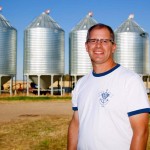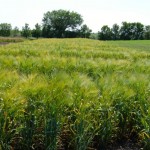Reading Time: 5 minutes The grain market bears are out in full force, but while times are challenging, there are ways to manage through the latest downward cycle, say four Alberta farm leaders. “In 1980 — 35 years ago — I was selling spring wheat for $6 a bushel,” said Gary Stanford, president of the Grain Growers of Canada. […] Read more

Business strategies for a down market
The bears are out, but here are some ways to manage through a time of tight margins and high risks

Manage crop residue with next year in mind
Reading Time: < 1 minute How you harvest, what you are using to harvest, and what you do with the residue will have a huge effect on what happens next spring. “Crop residue isn’t trash as it has a significant amount of fertilizer value,” said provincial crop specialist Harry Brook. “The straw has probably the lion’s share of this, as […] Read more

Clubroots beating all resistant canolas across Alta.
A study of 27 canola fields across Alberta has found 16 infected with clubroot pathotypes able to cause “high levels” of the disease — in canola plants with clubroot-resistant genetics. What’s more, the clubroot pathogen isolated from “many” of the infected fields in the study was virulent on all clubroot-resistant canola cultivars, the Canola Council of Canada […] Read more

Decisions on new-crop canola acres still pending
CNS Canada — With the 2015-16 growing season fast approaching in Western Canada, decisions on how many acres will be seeded to canola remain up in the air. “I think a lot of people aren’t getting a lot of feedback from growers, as they haven’t really indicated a lot of big changes in acres,” said […] Read more

Fababeans making more inroads on Prairies
CNS Canada — Fababean acres are on the rise in Western Canada, as the crop is seen as a good pulse alternative for producers seeking other options in their rotations. Better disease resistance and ease of harvest have been two selling points for the crop. “We’ve had significant uptake on fababeans,” said Leanne Fischbuch, executive […] Read more

Doing a better job of turning grass into grain — and saying so
Growing more forage is the right thing to do. Is the beef industry prepared if it happens?
Reading Time: 3 minutes If you’re looking for proof that there is no such thing as bad publicity, beef may be a good example. For years it’s been painted as a public health and environmental villain, and recently there were more reports on how bovine frontal and rearward methane emissions are a major source of climate-altering greenhouse gas. All […] Read more

Winter cereals match herbicides in controlling wild oats
Producers might be ‘fairly shocked,’ but study finds winter cereals are as effective as herbicides in wild oats control
Reading Time: 2 minutes Winter cereals control wild oats just as well as herbicides do, suggests a study underway in Lacombe. “When we had two years of winter cereals — either running or with an early-cut silage in between — we had as good of wild oat control as when we went three years of alfalfa or canola-wheat-canola-wheat with […] Read more

New root rots slamming Alberta pea growers
Producers across the Prairies are facing devastating losses in their pea crops — and new species of root rots may be to blame
Reading Time: 5 minutes On bad years — those with cool, wet springs; years like this one — Donald Mueller is lucky if his pea fields yield three bushels an acre. He’ll make back his seed and not much else, losing north of $400 an acre in inputs. Still, the good years have made up for the bad, so […] Read more

